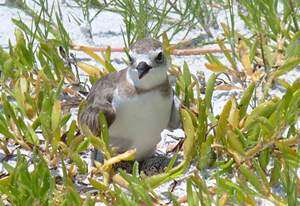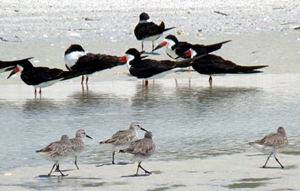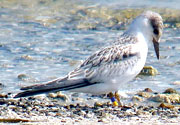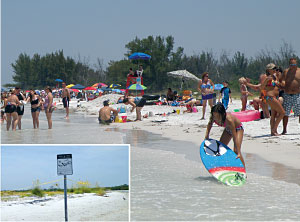 |
||||||||


By Victoria Parsons

Photo by Lorraine Margeson
A Wilson's plover sits on two eggs at Fort DeSoto Park. It's easy to see how well the eggs are camouflaged.

Photo by Lorraine Margeson
Black skimmers (above) and red knots share the shoreline at Fort DeSoto. About 75 pairs of skimmers are nesting at the park this year, but even small disturbances may cause their nests to fail. The red knots stopped to rest on their annual trip from the southern tip of South America north to breeding sites in the Arctic.

Photo by Marianne Korosy
Two royal tern chicks, just days old, are barely visible under the adults at the left. About 350 pairs of royal terns are nesting at Three Rooker Bar, near Honeymoon Island.
It's not much more than a line in the sand.
On one side, thousands of beachgoers romp on beautiful white sand beaches. Inside a roped-off sanctuary, hundreds of endangered birds are laying eggs, raising chicks or resting from their long migrations, just as they have for centuries.
In the middle, park rangers and volunteer stewards patrol the rope to protect the vulnerable habitat.
"The birds are running out of beach," says Saskia Janes, volunteer coordinator for the Suncoast Shorebird Partnership. "Even birds that are not officially listed as endangered have an uncertain future if their habitat has gone away."
Beach-nesting birds – including terns, willets, plovers, black skimmers and oystercatchers — don't build nests in the traditional sense. Instead, they dig shallow scrapes in the sand and depend upon camouflage for protection from predators. That worked well before people discovered Florida's beaches but their nearly invisible nests are easy to destroy unintentionally.
And even if the nests are not disturbed, intrusions by people or pets may cause the birds to fly off, leaving eggs or chicks in the blazing hot sun with no protection from predators. Too much turmoil and the birds will abandon their nests.
Volunteer stewards on beaches from Naples north to Honeymoon Island patrol the edges of roped-off sanctuaries every weekend and holidays during the summer. "A lot of what we do is education," adds Marianne Korosy, important bird area coordinator for Audubon of Florida. "We tell them about nesting birds and explain why that part of the beach is closed — most people think it's really neat once they understand that the birds need this little bit of beach to survive."
Terns Turn to Rooftops

A bird banded near Ulmerton Road in 2009 was spotted on a rooftop at Gateway Business Park earlier this summer.
Least terns are taking the high road – nesting on flat white rooftops across Pinellas County instead of on its crowded beaches. Small but feisty birds usually found in colonies of 100 or more, the least terns have been nesting in an office park off Ulmerton Road for several years. This year, they're also nesting at a condominium in Shore Acres as well as the Lockheed-Martin and FedEx buildings in the Gateway Business Center.
While humans aren't usually a problem on rooftops, they're still not safe places for birds that typically nest on the ground. Five shifts of volunteers from St. Petersburg Audubon monitor the sites off Ulmerton Road daily looking for birds that fall off the roof or down drain pipes. If they're large enough, they're banded to indicate when and where they were hatched. They're placed back on the roof with a "chick-a-boom" that deposits baby birds without upsetting the colony.
The Gateway buildings are too high for the chick-a-boom, so engineers from Lockheed-Martin helped to design drain guards that prevent the birds from falling. Property Manager Kim Circello worked with Audubon to organize access so guards could be installed on all 81 drain pipes.
Volunteers spotted a very special bird among the estimated 100 nests at the Gateway site –— a tern banded in 2009 just two miles away. "The banding project is giving us astounding least tern nesting data," said Audubon volunteer Lorraine Margeson. It's also thrilling for volunteers to see the long-term impact of their action. "The birds we banded had no chance of survival if we hadn't been there to save them," adds Margeson.
You Can Help!

Photos by Victoria Parsons
Thousands of beachgoers frolic at Fort DeSoto Park. Bird stewards are needed to help protect the
adjacent sanctuary shown in inset.
Volunteer stewards are needed on beaches to work weekends and holidays from May through October, depending upon the birds' nesting schedules. No special training is necessary, but pre-registration is required.
Please contact the following coordinators:
- Egmont Key: Joyce Galiardo at galibird@tampabay.rr.com or 727-397-5305
- Shell Key, Indian Shores and Fort DeSoto: Saskia Janes at icegull@netzero.com or 727- 481-7839
- Honeymoon Island: Karen Malo at Karen.Malo@dep.state.fl.us
- North Pinellas County Beaches, Pasco and Manatee counties: Marianne Korosy at mkorosy@audubon.org or 727-742-1683.
To sign up as a chick-checker for least terns nesting on rooftops through mid-July, contact Dave Kandz at conservation@stpeteaudubon.org or Beth Forys at forysea@eckerd.edu.
